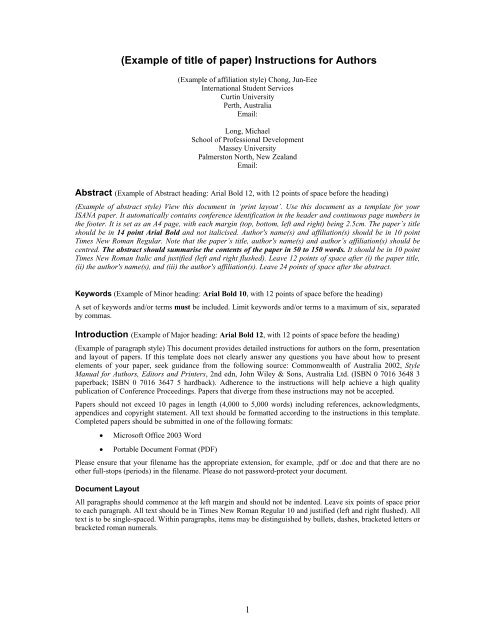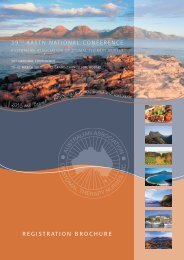(Example of title of paper) Instructions for Authors - Conference ...
(Example of title of paper) Instructions for Authors - Conference ...
(Example of title of paper) Instructions for Authors - Conference ...
Create successful ePaper yourself
Turn your PDF publications into a flip-book with our unique Google optimized e-Paper software.
(<strong>Example</strong> <strong>of</strong> <strong>title</strong> <strong>of</strong> <strong>paper</strong>) <strong>Instructions</strong> <strong>for</strong> <strong>Authors</strong><br />
(<strong>Example</strong> <strong>of</strong> affiliation style) Chong, Jun-Eee<br />
International Student Services<br />
Curtin University<br />
Perth, Australia<br />
Email:<br />
Long, Michael<br />
School <strong>of</strong> Pr<strong>of</strong>essional Development<br />
Massey University<br />
Palmerston North, New Zealand<br />
Email:<br />
Abstract (<strong>Example</strong> <strong>of</strong> Abstract heading: Arial Bold 12, with 12 points <strong>of</strong> space be<strong>for</strong>e the heading)<br />
(<strong>Example</strong> <strong>of</strong> abstract style) View this document in ‘print layout’. Use this document as a template <strong>for</strong> your<br />
ISANA <strong>paper</strong>. It automatically contains conference identification in the header and continuous page numbers in<br />
the footer. It is set as an A4 page, with each margin (top, bottom, left and right) being 2.5cm. The <strong>paper</strong>’s <strong>title</strong><br />
should be in 14 point Arial Bold and not italicised. Author's name(s) and affiliation(s) should be in 10 point<br />
Times New Roman Regular. Note that the <strong>paper</strong>’s <strong>title</strong>, author's name(s) and author’s affiliation(s) should be<br />
centred. The abstract should summarise the contents <strong>of</strong> the <strong>paper</strong> in 50 to 150 words. It should be in 10 point<br />
Times New Roman Italic and justified (left and right flushed). Leave 12 points <strong>of</strong> space after (i) the <strong>paper</strong> <strong>title</strong>,<br />
(ii) the author's name(s), and (iii) the author's affiliation(s). Leave 24 points <strong>of</strong> space after the abstract.<br />
Keywords (<strong>Example</strong> <strong>of</strong> Minor heading: Arial Bold 10, with 12 points <strong>of</strong> space be<strong>for</strong>e the heading)<br />
A set <strong>of</strong> keywords and/or terms must be included. Limit keywords and/or terms to a maximum <strong>of</strong> six, separated<br />
by commas.<br />
Introduction (<strong>Example</strong> <strong>of</strong> Major heading: Arial Bold 12, with 12 points <strong>of</strong> space be<strong>for</strong>e the heading)<br />
(<strong>Example</strong> <strong>of</strong> paragraph style) This document provides detailed instructions <strong>for</strong> authors on the <strong>for</strong>m, presentation<br />
and layout <strong>of</strong> <strong>paper</strong>s. If this template does not clearly answer any questions you have about how to present<br />
elements <strong>of</strong> your <strong>paper</strong>, seek guidance from the following source: Commonwealth <strong>of</strong> Australia 2002, Style<br />
Manual <strong>for</strong> <strong>Authors</strong>, Editors and Printers, 2nd edn, John Wiley & Sons, Australia Ltd. (ISBN 0 7016 3648 3<br />
<strong>paper</strong>back; ISBN 0 7016 3647 5 hardback). Adherence to the instructions will help achieve a high quality<br />
publication <strong>of</strong> <strong>Conference</strong> Proceedings. Papers that diverge from these instructions may not be accepted.<br />
Papers should not exceed 10 pages in length (4,000 to 5,000 words) including references, acknowledgments,<br />
appendices and copyright statement. All text should be <strong>for</strong>matted according to the instructions in this template.<br />
Completed <strong>paper</strong>s should be submitted in one <strong>of</strong> the following <strong>for</strong>mats:<br />
• Micros<strong>of</strong>t Office 2003 Word<br />
• Portable Document Format (PDF)<br />
Please ensure that your filename has the appropriate extension, <strong>for</strong> example, .pdf or .doc and that there are no<br />
other full-stops (periods) in the filename. Please do not password-protect your document.<br />
Document Layout<br />
All paragraphs should commence at the left margin and should not be indented. Leave six points <strong>of</strong> space prior<br />
to each paragraph. All text should be in Times New Roman Regular 10 and justified (left and right flushed). All<br />
text is to be single-spaced. Within paragraphs, items may be distinguished by bullets, dashes, bracketed letters or<br />
bracketed roman numerals.<br />
1
Headings<br />
See above <strong>for</strong> examples <strong>of</strong> Title, Abstract, Major and Minor headings.<br />
Very Minor Heading (<strong>Example</strong> <strong>of</strong> Very Minor Heading: Arial Regular 10, with six points <strong>of</strong> space be<strong>for</strong>e the<br />
heading)<br />
In-text Citations<br />
Citations should be in the author-date style (<strong>for</strong> example, the Harvard style). For example, a single author is<br />
referred to as (Smith 2004) or ‘as stated by Smith (2004)’. For two or three authors state all names (Hardin,<br />
Fuller & Davison 2007; Laudon & Laudon 2006). Four or more authors are referred to as Cater-Steel et al.<br />
(2006) or (Cater-Steel et al. 2006). Multiple publications by the same author within the same year are<br />
differentiated as Smith (2002a; 2002b). Where the author is unknown, or is an organisation, an appropriate<br />
surname or organisation name or acronym is used, <strong>for</strong> example, (ABS 2002; Anon 2004; ISO 2005).<br />
Researchers using Endnote Bibliographic s<strong>of</strong>tware, download the ‘Harvard-AGPS modified’ style file from<br />
Victoria University at http://w2.vu.edu.au/library/endnote/styles.htm<br />
The following in<strong>for</strong>mation about short and long quotations is sourced from the University <strong>of</strong> South Australia at<br />
http://www.unisanet.unisa.edu.au/learningconnection/student/learningAdvisors/refstyles.asp<br />
Short quotations are fewer than 30 words or two lines. They should be written in single quotation marks (‘.…’)<br />
and as part <strong>of</strong> your own sentence. They are followed by an in-text reference including a page number. For<br />
example:<br />
A recent report showed that ‘the levels in the soil were critical’ (Ang 2005, p.6)<br />
Long quotations are more than 30 words or two lines. They should be written without any quotation marks,<br />
indented (using the Tab key) at the left. A smaller type size can be used. Long quotes are followed by an in-text<br />
reference including a page number. For example:<br />
It has been suggested that:<br />
Australians have developed an emerging interest in values, vision, meaning and purpose, which is the<br />
common characteristic <strong>of</strong> societies facing the end <strong>of</strong> a chronological era … each new decade is<br />
approached as if it holds some new promise (Mackay 1993, p.231)<br />
Given the current climate in Australia, these observations from social research would seem to be supported.<br />
The three dots after the word ‘era’ in the above quotation indicates that a word or words have been left out.<br />
Tables and Figures<br />
Tables<br />
Set the table number and <strong>title</strong> in italics, centred above table. There is 10 points <strong>of</strong> space between the table’s <strong>title</strong><br />
and the table. Use 20 points <strong>of</strong> space between tables and the text that follows it (see Table 1 as an example.)<br />
Table 1. Students’ IELTS scores and exam per<strong>for</strong>mance<br />
Student number IELTS band score (writing) Exam 1 score Exam 2 score<br />
1 6.0 74/100 62/100<br />
2 6.0 72/100 85/100<br />
3 7.0 71/100 80/100<br />
4 7.0 65/100 55/100<br />
5 6.0 80/100 68/100<br />
Figures<br />
Figure captions use Times New Roman Italic 10 and should be placed below each illustration. Figures and figure<br />
captions should be centred (see Figure 1 on the next page as an example). Two narrow figures may be placed<br />
side-by-side. Leave 20 points <strong>of</strong> space between the figure caption and the text that follows it.<br />
2
Figure 1. International students enrolled at Australian universities, 1993-2002 (Smith 2004, p.6)<br />
References<br />
The references section should immediately follow the last section in the text. Do not start a new page. Sufficient<br />
descriptions should be given to enable the reader to locate all publications referred to in the text. They should be<br />
arranged in alphabetical order by surname <strong>of</strong> first-named author, then date. Unpublished works or private<br />
communications that are mentioned within the text must be included in the reference list. References to<br />
electronic documents should include an appropriate Universal Resource Locator (URL) and date <strong>of</strong> access.<br />
Following are examples <strong>of</strong> appropriate Harvard <strong>for</strong>mats <strong>for</strong> the References section and are sourced from<br />
UNSW’s Learning Centre Website at http://www.lc.unsw.edu.au/onlib/ref2.html and<br />
http://www.lc.unsw.edu.au/onlib/ref2.html<br />
Books<br />
Smith, G & Brown, J 1993, Introduction to sociology, UNSW Press, Sydney.<br />
Ward, R 1966, The Australian legend, 2nd edn, Ox<strong>for</strong>d University Press, Melbourne.<br />
Articles from a Book Collection<br />
When a book consists <strong>of</strong> a collection <strong>of</strong> articles, each by different authors, but with editor(s), use the following<br />
layout:<br />
Marton, F, Hounsell, D & Entwistle, N (eds) 1982, The experience <strong>of</strong> learning, Scottish Academic Press,<br />
Edinburgh.<br />
When you use an article from a book collection, the <strong>title</strong> <strong>of</strong> the article appears in quotations. The <strong>title</strong> <strong>of</strong> the<br />
book is italicised. Here is an example:<br />
Curthoys, A 1997, ‘History and identity’, in W Hudson & G Bolton (eds), Creating Australia: Changing<br />
Australian history, Allen & Unwin, Australia.<br />
Journal Articles<br />
Kozulin, A 1993, ‘Literature as a psychological tool’, Educational Psychologist, vol. 28, no. 3, summer, pp.<br />
253-265.<br />
Souban, J C, Kouzman, T H, & Whitman, W 1991, ‘A sociological survey into enterprise bargaining’, Journal<br />
<strong>of</strong> the Australian Sociological Association, vol. 6, no. 3, pp. 23-45.<br />
3
To reference a document within a website:<br />
Winston, J 1999, A look at referencing, AAA Educational Services, viewed 20 October 2002,<br />
.<br />
Saxton, A 1975, ‘Blackface minstrelsy and Jacksonian ideology’ in American Quarterly, Vol. 27, No. 1, March<br />
1975, pp. 3-28, viewed 11 April 2003,<br />
.<br />
To reference a website:<br />
International Narcotics Control Board 1999, United Nations, Vienna, viewed 1 October 1999,<br />
.<br />
A news<strong>paper</strong> article with a named author<br />
Donaghy, B 1994, ‘National meeting set to review tertiary admissions’, Campus News, 3-9 Mar, p. 3.<br />
A news<strong>paper</strong> article where the author details are unknown<br />
‘UNSW gains top ranking from quality team’, Sydney Morning Herald, 30 February, 1994, p.21.<br />
Film, video, television and radio programs<br />
Cutting Edge: Neighbours, 4 May 1992, Video, Channel Four, United Kingdom.<br />
Government publications<br />
Give the name <strong>of</strong> the ministry or agency that has issued the report:<br />
Department <strong>of</strong> Education, Employment & Training, 1992, Annual Report 1991-92, AGPS, Canberra.<br />
CD_ROMS<br />
These are the same as <strong>for</strong> Film, Video TV and Radio recordings.<br />
Email communications<br />
Private emails (those sent between individuals or small groups) are the same as personal communications. See<br />
http://www.lc.unsw.edu.au/onlib/ref1.html#harvard3<br />
Acknowledgements<br />
Acknowledgements should follow the references. Do not start a new page.<br />
Appendix 1<br />
Appendices are the last section <strong>of</strong> the <strong>paper</strong>. Do not start a new page.<br />
Author’s Responsibility<br />
<strong>Authors</strong> are to ensure the accuracy <strong>of</strong> their <strong>paper</strong>s. The conference organisers accept no responsibility <strong>for</strong><br />
statements made by authors either in written <strong>paper</strong>s or in presentations.<br />
Where relevant, authors are to ensure that the contents <strong>of</strong> their <strong>paper</strong>s are cleared <strong>for</strong> publication, <strong>for</strong> example,<br />
by their employer, their client, the funding organisation and/or the copyright owner <strong>of</strong> any material which is<br />
reproduced.<br />
Copyright<br />
<strong>Authors</strong> retain their copyright in the <strong>paper</strong>. The ISANA International Education Association Inc., as publisher <strong>of</strong><br />
the <strong>Conference</strong> Proceedings, will claim copyright in the collection.<br />
4
The following copyright statement must be included at the end <strong>of</strong> the <strong>paper</strong>. Do not include the author/s names<br />
in the initial submission. The names should be inserted <strong>for</strong> the final copy.<br />
[Author/s names] © 2008. The authors assign to ISANA and educational and non-pr<strong>of</strong>it institutions a nonexclusive<br />
licence to use this document <strong>for</strong> personal use and in courses <strong>of</strong> instruction provided that the article is<br />
used in full and this copyright statement is reproduced. The authors also grant a non-exclusive licence to ISANA<br />
to publish this document in full in the <strong>Conference</strong> Proceedings. Those documents may be published on the<br />
World Wide Web, CD-ROM, in printed <strong>for</strong>m, and on mirror sites on the World Wide Web. Any other usage is<br />
prohibited without the express permission <strong>of</strong> the authors.<br />
5




